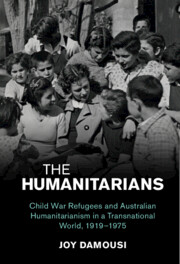 The Humanitarians
The Humanitarians Near East Relief and American Networks 1920s–1930s
from Part I - Saving
Published online by Cambridge University Press: 28 July 2022
Chapter 2 focuses on the Armenian Relief Fund and the Armenian Australasian Orphanage in Antilyas, in modern-day Lebanon. Children are rarely identified as the agents of change in international diplomacy, but during the immediate post-war period, the plight of the children was viewed as vital to the Armenian Relief Fund, created in 1915. This organisation defined Australian internationalism and humanitarianism during the interwar years. The Australasian Orphanage was established in 1923 and supported by the Near East Relief Fund in collaboration with American humanitarians. The Orphanage was a direct way to promote saving the refugees, and the campaign attracted significant support in Australia. The leading figures of this campaign – humanitarian activists Loyal Lincoln Wirt, Mary Serle, Reverend James Creswell, Edith Glanville and Ernest and Mary Bryce – energetically promoted the cause of those affected by the Armenian genocide, and the Orphanage became the focus of their efforts. This campaign is significant too because on many occasions efforts were made to transport Armenian orphans to Australia to save them, challenging the rigidity of the White Australia policy. Importantly, Mary and Ernest Bryce were the only activists who connected both the Armenian and Indigenous causes, identifying the destruction of Indigenous Australians as a genocide in the same way the destruction of the Armenian communities was described. In the Australian context, this campaign, it is argued, also marked a new break from British ties to a collaboration with American humanitarians.
To save this book to your Kindle, first ensure [email protected] is added to your Approved Personal Document E-mail List under your Personal Document Settings on the Manage Your Content and Devices page of your Amazon account. Then enter the ‘name’ part of your Kindle email address below. Find out more about saving to your Kindle.
Note you can select to save to either the @free.kindle.com or @kindle.com variations. ‘@free.kindle.com’ emails are free but can only be saved to your device when it is connected to wi-fi. ‘@kindle.com’ emails can be delivered even when you are not connected to wi-fi, but note that service fees apply.
Find out more about the Kindle Personal Document Service.
To save content items to your account, please confirm that you agree to abide by our usage policies. If this is the first time you use this feature, you will be asked to authorise Cambridge Core to connect with your account. Find out more about saving content to Dropbox.
To save content items to your account, please confirm that you agree to abide by our usage policies. If this is the first time you use this feature, you will be asked to authorise Cambridge Core to connect with your account. Find out more about saving content to Google Drive.